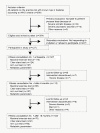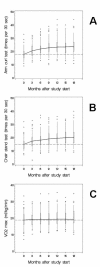Fitness consultations in routine care of patients with type 2 diabetes in general practice: an 18-month non-randomised intervention study
- PMID: 21047400
- PMCID: PMC2984455
- DOI: 10.1186/1471-2296-11-83
Fitness consultations in routine care of patients with type 2 diabetes in general practice: an 18-month non-randomised intervention study
Abstract
Background: Increasing physical activity is a cornerstone in the treatment of type 2 diabetes and in general practice it is a challenge to achieve long-term adherence to this life style change. The aim of this study was to investigate in a non-randomised design whether the introduction of motivational interviewing combined with fitness tests in the type 2 diabetes care programme was followed by a change in cardio-respiratory fitness expressed by VO2max, muscle strength of upper and lower extremities, haemoglobin A1c (HbA1c) and HDL-cholesterol.
Methods: Uncontrolled 18-month intervention study with follow-up and effect assessment every 3 months in a primary care unit in Denmark with six general practitioners (GPs). Of 354 eligible patients with type 2 diabetes, 127 (35.9%) were included. Maximum work capacity was tested on a cycle ergometer and converted to VO2max. Muscle strength was measured with an arm curl test and a chair stand test. The results were used in a subsequent motivational interview conducted by one of the GPs. Patients were encouraged to engage in lifestyle exercise and simple home-based self-managed exercise programmes. Data were analysed with mixed models.
Results: At end of study, 102 (80.3%) participants remained in the intervention. Over 18 months, VO2max increased 2.5% (p = 0.032) while increases of 33.2% (p < 0.001) and 34.1% (p < 0.001) were registered for the arm curl test and chair stand test, respectively. HDL-cholesterol increased 8.6% (p < 0.001), but HbA1c remained unchanged (p = 0.57) on a low level (6.8%). Patients without cardiovascular disease or pain from function limitation increased their VO2max by 5.2% (p < 0.0001) and 7.9% (p = 0.0008), respectively.
Conclusions: In this 18-month study, participants who had repeated fitness consultations, including physical testing and motivational interviewing to improve physical activity, improved VO2max, muscle strength, and lipid profile. Our results indicate that physical testing combined with motivational interviewing is feasible in a primary health care setting. Here, a fitness consultation tailored to the individual patient, his/her comorbidities and conditions in the local area can be incorporated into the diabetes programme to improve patients' muscle strength and cardio-respiratory fitness.
Figures
Similar articles
-
Exercise on prescription: trial protocol and evaluation of outcomes.BMC Health Serv Res. 2007 Mar 2;7:36. doi: 10.1186/1472-6963-7-36. BMC Health Serv Res. 2007. PMID: 17331263 Free PMC article. Clinical Trial.
-
Effects of a community-based exercise and motivational intervention on physical fitness of subjects with type 2 diabetes.Eur J Public Health. 2019 Apr 1;29(2):281-286. doi: 10.1093/eurpub/cky140. Eur J Public Health. 2019. PMID: 30052924
-
Effectiveness of a training course for general practice nurses in motivation support in type 2 diabetes care: a cluster-randomised trial.PLoS One. 2014 May 5;9(5):e96683. doi: 10.1371/journal.pone.0096683. eCollection 2014. PLoS One. 2014. PMID: 24798419 Free PMC article. Clinical Trial.
-
Psychological interventions to improve self-management of type 1 and type 2 diabetes: a systematic review.Health Technol Assess. 2020 Jun;24(28):1-232. doi: 10.3310/hta24280. Health Technol Assess. 2020. PMID: 32568666 Free PMC article.
-
Association Between Physical Exercise Interventions Participation and Functional Capacity in Individuals with Type 2 Diabetes: A Systematic Review and Meta-Analysis of Controlled Trials.Sports Med Open. 2022 Mar 4;8(1):34. doi: 10.1186/s40798-022-00422-1. Sports Med Open. 2022. PMID: 35244804 Free PMC article.
Cited by
-
Discontinuously supervised aerobic training vs. physical activity promotion in the self-management of type 2 diabetes in older Italian patients: design and methods of the 'TRIPL-A' randomized controlled trial.BMC Geriatr. 2019 Jan 11;19(1):11. doi: 10.1186/s12877-018-1022-x. BMC Geriatr. 2019. PMID: 30634923 Free PMC article. Clinical Trial.
-
'Function First': how to promote physical activity and physical function in people with long-term conditions managed in primary care? A study combining realist and co-design methods.BMJ Open. 2021 Jul 27;11(7):e046751. doi: 10.1136/bmjopen-2020-046751. BMJ Open. 2021. PMID: 34315792 Free PMC article.
-
Impact of a Discontinuous Training Program on Sedentary Behavior in Italian Type 2 Diabetes Older Patients: The Results of the TRIPL-A Randomized Controlled Trial.Healthcare (Basel). 2024 Apr 17;12(8):848. doi: 10.3390/healthcare12080848. Healthcare (Basel). 2024. PMID: 38667610 Free PMC article.
-
Predictors of exercise intervention dropout in sedentary individuals with type 2 diabetes.J Cardiopulm Rehabil Prev. 2012 Nov-Dec;32(6):370-8. doi: 10.1097/HCR.0b013e31826be485. J Cardiopulm Rehabil Prev. 2012. PMID: 23011489 Free PMC article. Clinical Trial.
-
Home-based circuit training improves blood lipid profile, liver function, musculoskeletal fitness, and health-related quality of life in overweight/obese older adult patients with knee osteoarthritis and type 2 diabetes: a randomized controlled trial during the COVID-19 pandemic.BMC Sports Sci Med Rehabil. 2024 Jun 3;16(1):125. doi: 10.1186/s13102-024-00915-4. BMC Sports Sci Med Rehabil. 2024. PMID: 38831437 Free PMC article.
References
-
- Wei M, Gibbons LW, Kampert JB, Nichaman MZ, Blair SN. Low cardiorespiratory fitness and physical inactivity as predictors of mortality in men with type 2 diabetes. Ann Intern Med. 2000;132:605–611. - PubMed
-
- Rikli RE, Jones CJ. Senior Fitness Test Manual. Human Kinetics, Champaign IL; 2001.
Publication types
MeSH terms
Substances
LinkOut - more resources
Full Text Sources
Medical



